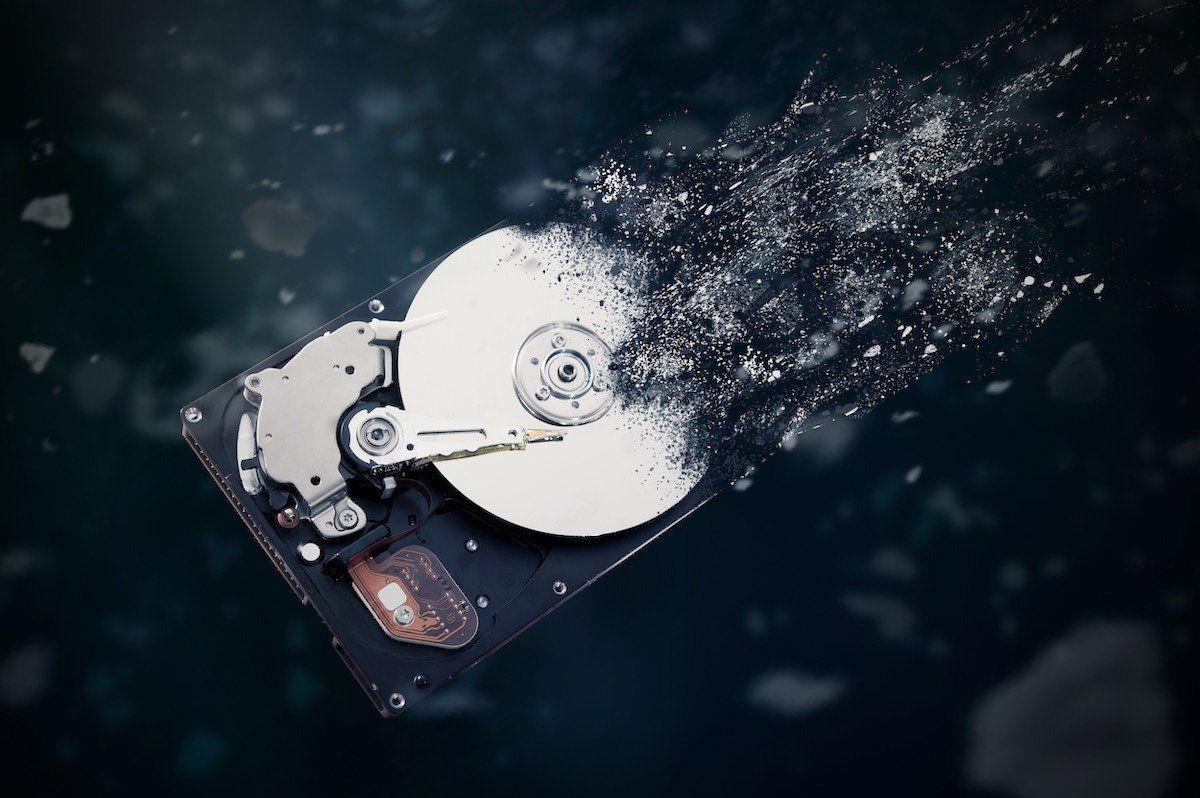Data Destruction
Data Wiping & Data Destruction meeting NIST SP 800-88 Guidelines
As technology continues to evolve at a rapid pace, many of us are constantly upgrading to the latest and greatest gadgets and devices. However, this can leave us with a surplus of old electronic devices that we no longer use.
While it may be tempting to simply throw these devices in the trash, it is essential to consider the data that may be stored on them.

When we use electronic devices, such as computers, smartphones, and tablets, we often store a wealth of personal and business-sensitive information on them. This can include things like financial information, passwords, and confidential business documents.
If these devices are simply thrown in the trash without adequately erasing the data on them, it is possible for that data to be accessed by someone else. This could potentially lead to identity theft, financial fraud, or unauthorized access to confidential information.
To protect against these risks, it is crucial to properly erase the data on old electronic devices before disposing of them. This can be done through a process called data destruction, which involves permanently and securely erasing the data on the device.
Surplus Service can protect you by eradicating data from your old electronic equipment, while meeting NIST 800-88 guidelines
There are multiple ways to ensure that secure information is handled with care, but the main tools our Data Destruction Services, use are data wiping, degaussing and destruction. With data wiping, the information on the hard drive is removed for good and can’t be recovered. Degaussing is the process of removing stored data from a hard drive using a magnet. If devices are still functional, we make sure the electronic assets are refurbished or broken down into parts. Preventing any part of your device from ending up in a landfill.
Another method for Data Eradication is to remove the physical hard drive from your electronic device and destroy it using physical force.
Like degaussing, data shredding destroys the hard drive in a few different ways.
This method shreds up a hard drive like a paper shredder, and your device gets sorted into raw commodities, such as plastics and metals.
Services we offer...
Data Wiping
Data Destruction
Disk Degaussing
Disk Shredding
Certificate of Destruction
Why you should choose Surplus Service for Secure Data Destruction?
There are multiple ways to ensure that secure information is handled with care, but the main tools our Data Destruction Services use are data wiping, degaussing and destruction. With data wiping, the information on the hard drive is removed for good and cannot be recovered. Degaussing is the process of removing stored data from a hard drive using a magnet. If devices are still functional, we make sure the electronics are refurbished or broken down into parts for reuse or resale, preventing any part of your device from ending up in a landfill.
Another method for Data Eradication is to remove the physical hard drive from your electronic device and destroy it using physical force. Like degaussing, data shredding destroys the hard drive in a few different ways. This method shreds up a hard drive like a paper shredder, and your device gets sorted into raw commodities, such as plastics and metals.
At Surplus Service, our Data Destruction Services meets DoD 5200.22-M and NIST 800-88 standards to keep your data safe and out of the hands of data thieves.
Demanufacturing is the term used to describe the disassembly of electrical devices in order to recover component parts and recycle waste metal.
The hazardous components are recovered by Surplus Service, lowering the toxicity of the waste and ensuring proper disposal or recycling for the remaining waste stream.
Recovery of raw materials results in their eventual redistribution for the production of metals, polymers, and glass.
Hazardous parts are taken out of the equipment and disposed of in accordance with state, federal, and municipal laws. Examples include batteries on circuit boards, portable equipment, mercury switches, hazardous capacitors, leaded glass from monitors, etc.
Materials that aren’t dangerous are recycled into plastic or metal products.
Each pallet’s processing is recorded as the job progresses.
A certificate of destruction that includes the make, model, S/N, and asset tag, if applicable, will be sent to the customer.
Due to this service’s huge reduction in the quantity of e-waste that ends up in landfills, you may feel confident in your commitment to playing a part in environmental protection.
Our services help our customers be compliant with the following regulations:
- HIPAA
- Health Insurance Portability and Accountability Act
- HECVAT
- ISO 19001
- ISO 14001
- ISO 45001
- R2v3
- NIST 800-88
- Various state laws
For regulatory needs, we can provide a detailed audit trail of every destroyed media, including serial numbers and makers.
We are well conversant with all data deletion rules and can assist you with your compliance efforts.
We accept ownership of the media, input it into our ERP system, either physically or digitally cleanse the data, and then provide a certificate of destruction.

Our Data Destruction Method

Data Destruction Process Statement
Surplus Service adheres to the National Institute of Standards and Technology (NIST) Guidelines for Media Sanitization.
Refer to NIST Special Publication 800-88 for in-depth information on media sanitization options.
Surplus Service has a documented and provable procedure for physically destroying (rather than deleting or overwriting) ordinary computer hard disks.
All physically destroyed media is disposed in a responsible manner.
Surplus Service follows a zero-landfill policy.
While several of these variables may affect the choice to utilize or avoid a certain media sanitization procedure, the needed level of security and secrecy is often the most important one.
There may still be solutions for disposing of the remaining media in a sustainably acceptable manner if physical destruction of the media is required.
- We find ways to recycle the by-product if media is made useless by abrasive scraping, shredding, dissolving, or pulverizing.
- If possible, metals and polymers in damaged media are separated and melted down.
- If media is rendered useless by chemical degradation and cannot be recycled It require specific disposal.
Frequently Asked Questions about Data Destruction
-
What is Data Destruction?
Data destruction is the process of permanently and securely erasing data from a storage medium.
There are several methods that can be used for data destruction, and it is important to choose the right method for a given situation.
Data destruction is an essential step in protecting against unauthorized access to sensitive information.
-
What is Data Wiping?
Data wiping is the process of permanently and securely erasing data from a storage medium. It involves overwriting the data on the device multiple times, using a specialized software program.
There are several methods that can be used for data wiping, and it is important to choose the right method for a given situation.
Data wiping is an essential step in protecting against unauthorized access to sensitive information.
-
What is Disk Degaussing
Disk degaussing is a process that is used to securely erase data from a magnetic storage medium.
It involves exposing the disk to a strong magnetic field, which disrupts the magnetic patterns used to store data on the disk, effectively erasing the data.
While degaussing a disk is a permanent process, it is an important step in ensuring the security of sensitive data and protecting against unauthorized access.
-
What is Disk Shredding?
Disk shredding is the process of physically destroying a disk in order to securely erase the data stored on it.
It involves using a specialized machine, called a disk shredder, to shred the disk into small pieces.
There are several types of disk shredders that can be used for disk shredding, and it is important to choose the right type for a given situation.
Disk shredding is an essential step in protecting against unauthorized access to sensitive information.
-
What is NIST 800-88
NIST® 800-88 is a publication by the National Institute of Standards and Technology (NIST) that outlines best practices for media sanitization. It provides guidance for government organizations, private companies, and individual users on the proper procedures to ensure permanent erasure of data from digital storage devices. NIST 800-88 also contains criteria to ensure that data is not recoverable form media upon disposal or repurpose. As such, it is an important resource for ensuring sensitive information remains secure when no longer in use.
-
Why should I be concerned about my data?
As technology continues to evolve at a rapid pace, many of us are constantly upgrading to the latest and greatest gadgets and devices. However, this can leave us with a pile of old electronic devices that we no longer use. While it may be tempting to simply throw these devices in the trash, it is important to consider the data that may be stored on them.
When we use electronic devices, such as computers, smartphones, and tablets, we often store a wealth of personal and sensitive information on them. This can include things like our personal and financial information, passwords, and confidential business documents.
If these devices are simply thrown in the trash without properly erasing the data on them, it is possible for that data to be accessed by someone else. This could potentially lead to identity theft, financial fraud, or the unauthorized access of confidential information.
To protect against these risks, it is important to properly erase the data on old electronic devices before disposing of them. This can be done through a process called data destruction, which involves permanently and securely erasing the data on the device.
There are several methods that can be used for data destruction, including physical destruction, degaussing, and data wiping. Physical destruction involves physically destroying the device, making it impossible to access the data on it. Degaussing involves using a strong magnetic field to erase the data on the device, while data wiping involves overwriting the data on the device multiple times, making it impossible to recover.
-
What guarantees do I get that my data has been eradicated?
Describe the item or answer the question so that site visitors who are interested get more information. You can emphasize this text with bullets, italics or bold, and add links. -
What documentation do I receive?
Describe the item or answer the question so that site visitors who are interested get more information. You can emphasize this text with bullets, italics or bold, and add links. -
What happens to my disks?
Describe the item or answer the question so that site visitors who are interested get more information. You can emphasize this text with bullets, italics or bold, and add links.
Your e-waste needs are about to be solved. You are just one phone call away. Fill out the form and we’ll get back to you ASAP.
